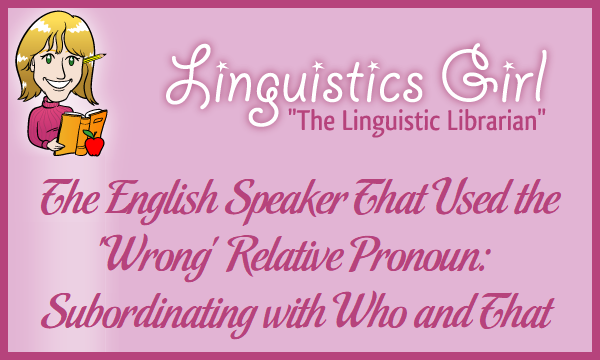According to the prescriptive grammar rule, the relative pronoun who should be used for people, and the relative pronoun that should be used for places and things. But why? I, as a native English speaker, say and hear both the person who and the person that. The difference to me and most native English speakers is a matter of style (with who being more formal and that being more informal) rather than grammatical correctness. So, why all the hatred for the English speaker that uses the “wrong” relative pronoun?
Etymology of Who and That
Before we debate the grammatical correctness of who versus that, let’s first take a lot at the history of these two relative pronouns. According to the Oxford English Dictionary, the first recorded use of that as a relative pronoun is from around 825. But, and somewhat surprising to the prescriptive grammarian, who as a relative pronoun is first recorded in only 1297. That that had been used as a relative pronoun in English for 472 years before who speaks volumes!
The shouting in support of that as a relative pronoun for people intensifies when we take a look at the OED definitions for the two words. The word who as a relative pronoun is defined as a “simple relative (of a person or persons), introducing a clause defining or restricting the antecedent and thus completing the sense.” In other words, who is a subordinating conjunction that introduces an adjective clause that describes a person or people. For example:
- the boy who lived
- the old lady who swallowed a fly
- the man who mistook his wife for a hat
The word that is similarly defined as a “general relative pronoun, referring to any antecedent, and used without inflexion irrespective of gender, number, and case” that “[introduces] a clause defining or restricting the antecedent, and thus completing its sense.” However, the OED goes on to add that that is used when “referring to persons or things.” Things. Okay. But, persons?! Only who can be used with persons…right?
The Flexibility of That
As every English major knows, the Oxford English Dictionary is the go-to source for word definitions and etymology. So, although, yes, who should only be used for people, that can clearly be used for both things and people. Unlike who, which is really used only for people (the table who seats six just sounds strange), that is relatively flexible. As I mentioned before, the use of that for people or things really depends on style. I might say to my husband in casual conversation “The neighbor that lives two houses down…” but would only ever write about the neighbor who lives two houses from my own.
So, the next time that annoying grammar know-it-all rattles off the rule about “who is for people, that is for things,” be the English speaker that sets them straight. Even the Oxford English Dictionary agrees that that refers to people or things.
References
DeCarrico, Jeanette S. 2000. The structure of English: Studies in form and function for language teaching. Ann Arbor, MI: The University of Michigan Press.
Jacobs, Roderick A. 1995. English syntax: A grammar for English language professionals. New York: Oxford University Press.
Justice, Laura M. & Helen K.Ezell. 2002. The syntax handbook: Everything you learned about syntax…but forgot. Eau Claire, WI: Thinking Publications.
O’Dwyer, Bernard T. 2000. Modern English structures: Form, function, and position. Peterborough, Ontario: Broadview Press.
Oxford English Dictionary




